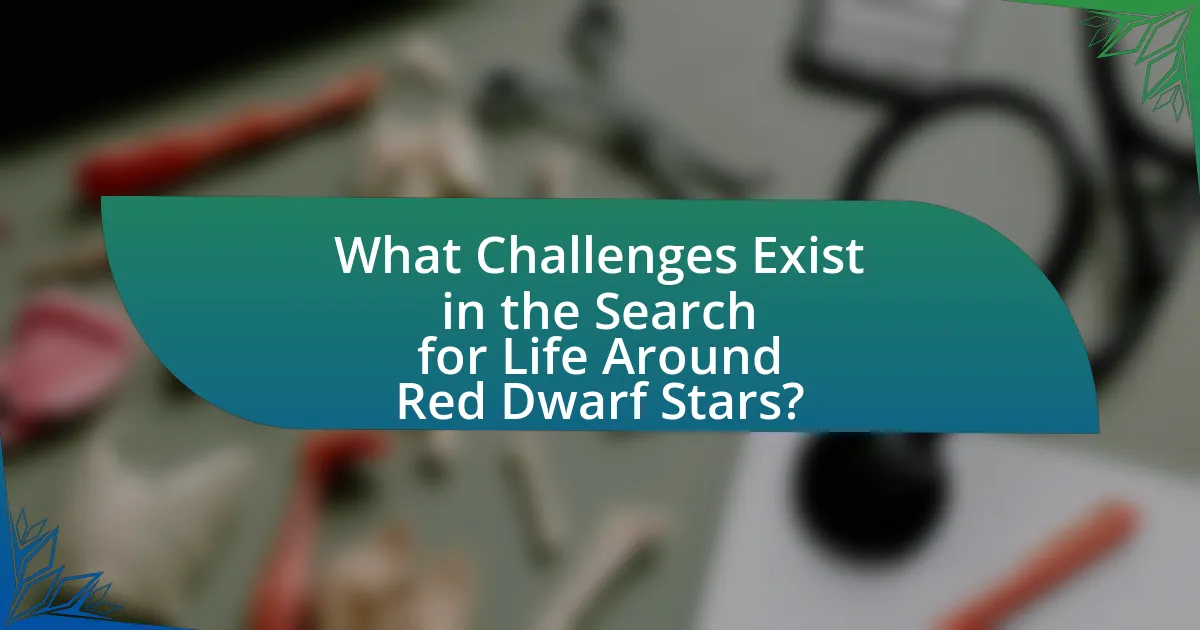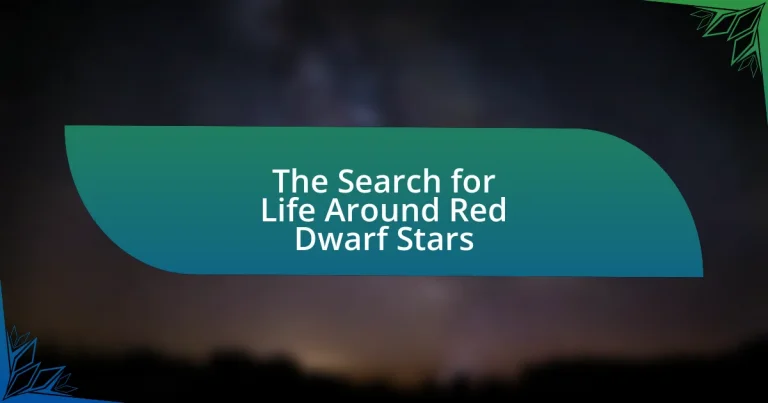Red dwarf stars, characterized by their small size, low temperature, and long lifespans, play a crucial role in the search for extraterrestrial life. These stars, which make up approximately 70-80% of all stars in the Milky Way, often host Earth-sized exoplanets within their habitable zones, where conditions may allow for liquid water. The article explores the unique characteristics of red dwarf stars, the challenges and opportunities they present for habitability, and the significant discoveries made in the ongoing quest to find life beyond Earth. It also discusses the implications of tidal locking, stellar activity, and the technological advancements aiding in the study of these stars and their planets.

What are Red Dwarf Stars and Why are They Important in the Search for Life?
Red dwarf stars are small, cool stars with a mass less than half that of the Sun, and they are significant in the search for life due to their long lifespans and the potential for habitable zones around them. These stars can burn for tens to hundreds of billions of years, providing a stable environment for planets to develop and sustain life. Additionally, many red dwarfs have been found to host Earth-sized exoplanets within their habitable zones, where conditions may allow for liquid water, a crucial ingredient for life. Studies, such as those conducted by NASA’s Kepler mission, have identified numerous planets orbiting red dwarfs, highlighting their importance in astrobiology and the ongoing search for extraterrestrial life.
How do Red Dwarf Stars differ from other types of stars?
Red dwarf stars differ from other types of stars primarily in their size, temperature, and longevity. They are smaller than main-sequence stars like our Sun, with masses ranging from about 0.08 to 0.6 solar masses, and they have surface temperatures between 2,500 to 4,000 Kelvin. This lower temperature results in a reddish color, which is why they are termed “red dwarfs.” Additionally, red dwarfs have significantly longer lifespans, often exceeding tens of billions of years, due to their slow rate of nuclear fusion compared to larger stars that burn out more quickly. This extended lifespan increases the potential for habitable conditions around them, making them a focal point in the search for extraterrestrial life.
What are the characteristics of Red Dwarf Stars?
Red dwarf stars are small, cool stars with a mass between 0.08 and 0.6 solar masses and a surface temperature ranging from about 2,500 to 4,000 Kelvin. These stars are characterized by their long lifespans, often exceeding tens of billions of years, due to their slow rate of nuclear fusion. Additionally, red dwarfs exhibit low luminosity, typically less than 0.1 times that of the Sun, and they are the most common type of star in the Milky Way galaxy, making up approximately 70-80% of all stars. Their stable and prolonged existence creates a favorable environment for the potential development of life on orbiting planets within their habitable zones.
Why are Red Dwarf Stars the most common type of star in the universe?
Red dwarf stars are the most common type of star in the universe due to their long lifespans and low mass. These stars, classified as M-type stars, burn hydrogen at a much slower rate than larger stars, allowing them to exist for tens to hundreds of billions of years. This longevity means they have more time to form and host planetary systems. According to the European Space Agency’s Gaia mission, red dwarfs make up about 70-80% of all stars in the Milky Way galaxy, highlighting their prevalence. Their low luminosity also allows them to remain undetected in many surveys, further contributing to their classification as the most common star type.
What role do Red Dwarf Stars play in astrobiology?
Red dwarf stars play a crucial role in astrobiology as they are the most common type of star in the universe and have long lifespans, providing stable environments for potential habitability. Their low luminosity allows for the existence of habitable zones much closer to the star, increasing the likelihood of planets within these zones maintaining liquid water, a key ingredient for life. Research indicates that many exoplanets orbiting red dwarfs are located in these habitable zones, making them prime targets for the search for extraterrestrial life. For instance, the TRAPPIST-1 system, which contains several Earth-sized planets in the habitable zone of a red dwarf, has garnered significant interest due to its potential for supporting life.
How do the habitable zones around Red Dwarf Stars compare to those around other stars?
The habitable zones around red dwarf stars are significantly closer to the star compared to those around larger stars like the Sun. Red dwarfs, which are cooler and less luminous, have habitable zones that can be located within a range of 0.03 to 0.1 astronomical units, whereas the habitable zone for a Sun-like star is typically between 0.95 to 1.5 astronomical units. This proximity means that planets in the habitable zone of red dwarfs may experience tidal locking, where one side of the planet always faces the star, potentially affecting climate and habitability. Additionally, red dwarfs have longer lifespans, often lasting tens to hundreds of billions of years, providing a stable environment for life to potentially develop.
What factors influence the potential for life around Red Dwarf Stars?
The potential for life around Red Dwarf Stars is influenced primarily by their stability, habitable zone location, and radiation levels. Red Dwarf Stars, being the most common type of star, have long lifespans, often exceeding tens of billions of years, which provides a stable environment for potential life to develop. The habitable zone, where conditions may allow for liquid water, is much closer to the star due to its lower luminosity, which can lead to tidally locked planets where one side perpetually faces the star. This can create extreme temperature gradients, affecting climate and habitability. Additionally, the lower levels of harmful radiation emitted by Red Dwarfs compared to larger stars can enhance the chances for life to thrive, as it reduces the risk of atmospheric stripping. These factors collectively shape the potential for life in the vicinity of Red Dwarf Stars.

What Challenges Exist in the Search for Life Around Red Dwarf Stars?
The search for life around red dwarf stars faces significant challenges primarily due to their stellar characteristics. Red dwarf stars are smaller and cooler than other types of stars, which results in a habitable zone that is much closer to the star. This proximity increases the likelihood of tidal locking, where one side of a planet always faces the star, leading to extreme temperature differences and potentially inhospitable conditions. Additionally, red dwarfs are known for their stellar flares, which can emit harmful radiation that may strip away planetary atmospheres, further complicating the potential for life. Studies indicate that these factors create a hostile environment for the development and sustainability of life, making the search for habitable planets around red dwarfs particularly challenging.
What are the main obstacles to detecting life around Red Dwarf Stars?
The main obstacles to detecting life around Red Dwarf Stars include their low luminosity, which limits the habitable zone to close proximity, and the high levels of stellar activity, such as flares, which can strip away planetary atmospheres. Red Dwarf Stars emit significantly less light than larger stars, making it challenging for planets in their habitable zones to maintain stable temperatures conducive to life. Additionally, the frequent and intense stellar flares can create harsh radiation environments that may hinder the development or sustainability of life. These factors complicate the search for biosignatures and the assessment of planetary habitability around these stars.
How does stellar activity affect the habitability of planets orbiting Red Dwarf Stars?
Stellar activity significantly impacts the habitability of planets orbiting Red Dwarf Stars by influencing their atmospheric stability and radiation exposure. Red Dwarf Stars, known for their frequent and intense stellar flares, can strip away the atmospheres of nearby planets, reducing their ability to support life. For instance, a study published in the journal “Astrobiology” by researchers from the University of California, Berkeley, indicates that the high levels of ultraviolet radiation emitted during these flares can lead to atmospheric erosion, particularly for planets within the habitable zone. This erosion can diminish the presence of essential elements like water and hinder the development of life-sustaining conditions.
What are the implications of tidal locking for potential life on these planets?
Tidal locking significantly impacts the potential for life on planets orbiting red dwarf stars by creating extreme temperature gradients and limiting the habitable zone. In a tidally locked scenario, one side of the planet perpetually faces the star, resulting in a hot, sunlit hemisphere, while the opposite side remains in constant darkness and cold. This stark contrast can hinder the development of stable climates and ecosystems necessary for life.
Research indicates that the habitable zone around red dwarfs is narrower and closer to the star, increasing the likelihood of tidal locking. A study by D. K. Kipping et al. (2016) in “The Astrophysical Journal” highlights that planets in this zone may experience atmospheric circulation patterns that could mitigate temperature extremes, potentially allowing for liquid water to exist in certain regions. However, the effectiveness of such circulation in supporting life remains uncertain.
Thus, while tidal locking presents challenges for habitability, it does not entirely preclude the possibility of life, depending on atmospheric conditions and other factors.
How do scientists overcome these challenges in their research?
Scientists overcome challenges in their research on the search for life around red dwarf stars by employing advanced observational techniques and interdisciplinary collaboration. They utilize space telescopes, such as the James Webb Space Telescope, to gather high-resolution data on exoplanets’ atmospheres, enabling the detection of potential biosignatures. Additionally, researchers collaborate across fields, combining expertise in astrophysics, planetary science, and biology to develop models that predict habitability conditions. This approach is supported by findings from studies like the one published in “Astrobiology” by authors including Sara Seager, which emphasizes the importance of understanding the unique environments of red dwarf systems.
What technologies are being developed to study Red Dwarf Stars and their planets?
Technologies being developed to study Red Dwarf Stars and their planets include advanced telescopes, spectrometers, and space missions. The James Webb Space Telescope (JWST) is designed to analyze the atmospheres of exoplanets orbiting these stars, providing insights into their composition and potential habitability. Additionally, ground-based observatories like the Extremely Large Telescope (ELT) will enhance our ability to detect and characterize planets around Red Dwarfs by utilizing adaptive optics to minimize atmospheric distortion. These technologies are crucial for understanding the conditions that may support life in the habitable zones of Red Dwarf systems.
How do astronomers prioritize which Red Dwarf systems to investigate?
Astronomers prioritize Red Dwarf systems for investigation based on factors such as the star’s proximity to Earth, its stability, and the presence of potentially habitable exoplanets. Proximity is crucial because closer stars allow for more detailed observations; for instance, Proxima Centauri, the nearest known star, is a prime target due to its closeness. Stability is important as more stable stars provide a consistent environment for potential life. Additionally, the discovery of exoplanets in the habitable zone, such as those in the TRAPPIST-1 system, further elevates the priority for investigation, as these planets may have conditions suitable for life.

What Discoveries Have Been Made in the Search for Life Around Red Dwarf Stars?
Discoveries in the search for life around red dwarf stars indicate that these stars may host habitable planets. Research has shown that many red dwarfs have planets in their habitable zones, where conditions could allow for liquid water. For instance, the TRAPPIST-1 system, which contains seven Earth-sized planets, has three located in the habitable zone, suggesting potential for life. Additionally, studies reveal that red dwarfs are more stable than previously thought, with less harmful radiation, which could enhance the chances for life to develop. These findings are supported by data from missions like Kepler and TESS, which have identified numerous exoplanets orbiting red dwarfs, reinforcing the idea that these stars are promising targets in the search for extraterrestrial life.
What exoplanets have been discovered around Red Dwarf Stars?
Numerous exoplanets have been discovered around red dwarf stars, including Proxima Centauri b, TRAPPIST-1 system planets (TRAPPIST-1b, TRAPPIST-1c, TRAPPIST-1d, TRAPPIST-1e, TRAPPIST-1f, TRAPPIST-1g), and LHS 1140 b. Proxima Centauri b, located in the habitable zone of the closest star to Earth, was confirmed in 2016 and is approximately 1.3 times the size of Earth. The TRAPPIST-1 system, discovered in 2017, contains seven Earth-sized planets, three of which are in the habitable zone. LHS 1140 b, identified in 2017, is a super-Earth located about 40 light-years away and is also situated in the habitable zone of its star. These discoveries highlight the potential for finding habitable conditions around red dwarf stars, which are the most common type of star in the Milky Way.
What are the most promising candidates for hosting life?
The most promising candidates for hosting life around red dwarf stars are exoplanets located in the habitable zone, particularly those like Proxima Centauri b, TRAPPIST-1e, and LHS 1140 b. Proxima Centauri b orbits the closest star to the Sun and is within the habitable zone, where conditions may allow for liquid water. TRAPPIST-1e is part of a system with multiple Earth-sized planets in the habitable zone, increasing the likelihood of finding life. LHS 1140 b is also situated in the habitable zone and has a size and mass that suggest it could retain an atmosphere. These candidates are supported by observations from telescopes such as the Kepler Space Telescope and the Transiting Exoplanet Survey Satellite (TESS), which have identified numerous exoplanets around red dwarfs, emphasizing their potential for habitability.
How do these exoplanets’ characteristics support the possibility of life?
Exoplanets’ characteristics, such as being located in the habitable zone, having Earth-like atmospheres, and possessing liquid water, significantly support the possibility of life. For instance, exoplanets like Proxima Centauri b are situated within their star’s habitable zone, where temperatures allow for liquid water to exist, a crucial ingredient for life as we know it. Additionally, the detection of atmospheres rich in essential gases, such as oxygen and methane, indicates potential biological processes. Research has shown that these conditions are similar to those on Earth, where life thrives, thus reinforcing the likelihood of life on these exoplanets.
What have we learned from the study of these exoplanets?
The study of exoplanets, particularly those orbiting red dwarf stars, has revealed that many of these planets exist within the habitable zone, where conditions may allow for liquid water. Research indicates that approximately 70% of red dwarf stars host at least one planet in this zone, suggesting a high potential for habitability. Additionally, studies have shown that some of these exoplanets possess atmospheres capable of supporting life, as evidenced by the detection of water vapor and other essential molecules. This information is crucial for understanding the potential for life beyond our solar system and guides future explorations and observations.
How do atmospheric conditions on these planets compare to Earth?
Atmospheric conditions on planets orbiting red dwarf stars often differ significantly from those on Earth. For instance, many of these planets may experience a thick atmosphere rich in carbon dioxide, leading to a greenhouse effect that can raise surface temperatures, unlike Earth’s nitrogen-oxygen atmosphere which supports life. Additionally, tidal locking, common in planets around red dwarfs, can create extreme temperature gradients between the day and night sides, affecting atmospheric circulation and weather patterns. Research indicates that planets like Proxima Centauri b may have atmospheres capable of supporting liquid water, but their conditions are likely harsher than those on Earth, with increased radiation exposure and potential for high-pressure environments.
What evidence suggests the presence of water or other life-supporting elements?
Evidence for the presence of water and other life-supporting elements around red dwarf stars includes the detection of exoplanets within the habitable zone, where conditions may allow for liquid water. For instance, the discovery of TRAPPIST-1, a system with seven Earth-sized planets, includes three in the habitable zone, suggesting potential for liquid water. Additionally, spectral analysis of atmospheres from exoplanets has revealed the presence of water vapor, carbon dioxide, and other essential compounds. The Kepler Space Telescope has identified numerous planets orbiting red dwarfs, with many located in regions where temperatures could support liquid water, reinforcing the possibility of life-supporting environments.
What practical steps can be taken to further the search for life around Red Dwarf Stars?
To further the search for life around Red Dwarf Stars, astronomers should focus on improving observational techniques and enhancing the study of exoplanets within the habitable zones of these stars. Utilizing next-generation telescopes, such as the James Webb Space Telescope, allows for detailed analysis of exoplanet atmospheres, which can reveal biosignatures indicative of life. Additionally, conducting targeted surveys of nearby Red Dwarf systems, like Proxima Centauri, can yield valuable data on planetary conditions and potential habitability. Research indicates that approximately 70% of stars in the Milky Way are Red Dwarfs, making them prime candidates for the search for extraterrestrial life.
What are the best practices for future missions targeting Red Dwarf systems?
The best practices for future missions targeting Red Dwarf systems include prioritizing the identification of habitable zones, utilizing advanced spectroscopic techniques for atmospheric analysis, and focusing on long-duration missions for in-depth study. Identifying habitable zones is crucial because many Red Dwarfs have narrow habitable zones due to their lower luminosity, making precise calculations essential for mission planning. Advanced spectroscopic techniques, such as transit spectroscopy, allow for the detection of biosignatures in exoplanet atmospheres, which is vital for assessing potential habitability. Long-duration missions enable comprehensive data collection over time, improving the understanding of planetary environments and their capacity to support life. These practices are supported by findings from studies like those conducted by the NASA Exoplanet Exploration Program, which emphasize the importance of targeted research in these unique stellar environments.
How can citizen science contribute to the search for life in these environments?
Citizen science can significantly contribute to the search for life around red dwarf stars by enabling large-scale data collection and analysis from amateur astronomers and enthusiasts. These individuals can monitor light curves, identify exoplanets, and contribute to the analysis of atmospheric compositions through spectroscopic observations. For instance, projects like Planet Hunters allow citizen scientists to analyze data from the Kepler Space Telescope, leading to the discovery of new exoplanets, including those in habitable zones of red dwarf stars. This collaborative effort enhances the volume of data processed and increases the likelihood of identifying biosignatures, thereby accelerating the search for extraterrestrial life.




